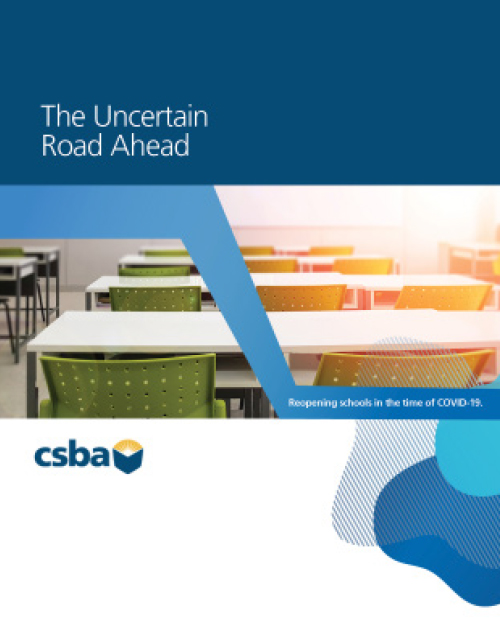
during the COVID-19 pandemic
“This pandemic has made clear what board members and educators have known all along — our public schools are a vital component of what makes our society function,” CSBA CEO & Executive Director Vernon M. Billy said. “We need to invest in schools now more than ever. Board members, teachers, administrative and classified staff have shown strength, creativity and resilience from the beginning of this crisis. Let us remember that California’s schools stepped up to the plate and continued learning for the state’s students when schools were closed abruptly. And let’s provide the financial support they need to weather this storm and continue to build new systems and structures for learning that can carry through to a post-pandemic world.”
 outlining California’s framework for moving forward amid the COVID-19 pandemic, Gov. Gavin Newsom said in an April news conference that schools will operate much differently than usual when they resume.
outlining California’s framework for moving forward amid the COVID-19 pandemic, Gov. Gavin Newsom said in an April news conference that schools will operate much differently than usual when they resume.As local educational agency leaders continue to plan for the 2020–21 school year, much remains uncertain, but the innovation and adaptability shown by California’s teachers, administrators, governing boards and students is sure to continue. Incredible work to serve students is happening throughout the state, and, in addition to outlining challenges, this article highlights just a tiny fraction of that work. LEAs must look to and support one another during this crisis, as they work to build a roadmap for the future of public education.
The first step for many districts was to survey their students and families to identify who needed devices and support in securing internet access. In ramping up distance learning, the time and resources LEAs spent on providing devices and internet access for students was largely dependent on how much focus was given to these issues prior to school closures.
in a COVID-19 world
While the announcement caused a number of alarmed reactions from education outfits throughout the state, it also prompted school leaders to begin thinking about what schools will look like when they reopen. East Side Union HSD Superintendent Chris Funk said he was starting to think through options such as block scheduling, where half the students are at school in the morning and half in the afternoon, or rotating groups of students to come into school on certain days and have distance learning for the remaining days of the week.
“The biggest thing for me is there is no way to reduce high school class sizes,” said Funk. “If the state doesn’t provide funding for that, there’s no possible way we have the finances for any of this.”
 CSBA’s new report, The Uncertain Road Ahead: Reopening Schools in the Time of COVID-19, presents a robust examination of what it will take to reopen schools safely and effectively.
CSBA’s new report, The Uncertain Road Ahead: Reopening Schools in the Time of COVID-19, presents a robust examination of what it will take to reopen schools safely and effectively.
The Uncertain Road Ahead provides important, in-depth resources related to the health and safety of students and faculty, equity, funding and flexibility, and high-quality teaching and learning. The guidance can be used as a framework in which district and county office boards make decisions based on their local circumstances.
Find the report at www.csba.org/coronavirus.

Having experience using technology and the dedication of the district’s leaders and staff enabled a smooth transition to distance learning, said Valencia Mayfield, assistant superintendent of academic services. “We have a board that is very competent in its district leadership. And that’s significant when you’re dealing and responding to a crisis situation, because it really does inspire you to be innovative and allow you to be very responsive in an abbreviated amount of time,” Mayfield said. “It is a credit to the work ethics of the district team and school teams who, I would say, from Friday night to Sunday night [after the closure], we did not sleep. We were grading, designing, inventing, challenging ourselves, pushing each other, asking critical questions — with the students in the center of that whole conversation. What can we do best for our students and how do we ensure that teachers are ready to deliver quality instruction from home?”
Part of TIP is integrating on-site and online curriculum in the district. Mayfield pointed to the district’s practice of involving the IT team in textbook adoptions to ensure that the process includes curriculum that can be supported and facilitated through the Google Classroom platform. Superintendent Mary Sieu emphasized how this five-year initiative helped the transition to distance learning go much more smoothly. “The Online Learning At Home program can be customized to what students need right now,” Sieu said. “The students and families still have access to the very programs that they have had while they have been in school.”
In rural areas, it can be much harder to not only reach students but to provide them with the resources they need to meaningfully engage in distance learning. However, these obstacles are not stopping the state’s less-populated districts from making sure their students are still learning. In the 1,370-student Plumas Lake Elementary School District, only a handful of students were still struggling with internet access at the time of this writing. The Yuba County district identified who needed devices such as Chromebooks and laptops and distributed them, but there was still the problem of internet access for all students. Superintendent Jeff Roberts said it is a real challenge to connect these isolated areas, meaning schools have to be creative.
“Some of the things that we’ve done is to open up our school sites so that people can use the parking lots and tables that we put there so they can socially distance and still use the internet,” Roberts said. “We moved where the access points are.”
At the opposite end of the geographic spectrum from Plumas Lake ESD lies Los Angeles USD. The nation’s second-largest district serves nearly 600,000 students, with 80 percent from low-income families. As many as one in three LAUSD students lack access to digital devices and the internet at home, according to LAUSD trustee Kelly Gonez, so the path to distance learning was multi-faceted. “The district began by first distributing all available devices at our school sites on the final day of in-person instruction before our facilities closure,” Gonez said. “However, since not every school had one device per student, we knew there were gaps that needed to be filled quickly. Shortly thereafter, LA Unified announced a $100 million investment (with Verizon) in devices and WiFi hotspots to ensure all of our students could participate online. As school districts, government agencies, and private businesses all have a sudden demand for devices, we have had weekly deliveries of our device orders and then distribute devices as they become available.”
All teachers were required to complete a 10-hour professional development series on distance learning. The district has also made available an optional 30-hour “Future Ready Certification” for teachers and school leaders who want to engage more deeply in online learning.
In San Jose’s East Side Union High School District, an innovative project to provide widespread internet access is underway, but only partially completed. The Community Wireless Project, a partnership between the city of San Jose and East Side Union HSD, has been a centerpiece of the mayor’s office’s plan to help with digital inclusion in San Jose, said Superintendent Chris Funk. The project is building one of the nation’s first school district-funded municipal WiFi infrastructures, bringing free broadband access to thousands of district families and tens of thousands of residents in East Side.
“The first step was James Lick High School — the entire community that borders that school is connected to the city’s wireless program, and we paid for the installation of that,” said Funk. “The city has now opened it up to the entire community. So, 6,000 residents in the James Lick are online. Two of our other high schools will be coming online, one in July here, the other one right after. That’s what we had finances for initially, I’m hoping to finish the rest of the district with some support from the feeder districts and maybe private sector; it will be about another $7 million to get us all wireless.”
“In many parts of the country, school districts are now the food-distribution centers; they are better positioned to make sure families are getting fed during this time when many families are not working and don’t have income,” said Noguera. “That should serve as a reminder that schools are a critical part of the social safety net in this country, and not just for children. But without schools, there are a lot of kids whose basic needs will go unmet.”
The largest operation in the state belongs to LAUSD, where, just in the first week and half of opening its 60 grab-and-go food centers, more than 2.3 million meals were distributed, according to district officials. As of April 20, more than 10 million meals had been served. The effort has involved partnerships with local foodbanks as well as celebrity chef José Andres. Meal-distribution sites are staffed by hundreds of volunteers coordinated through the American Red Cross.
“Los Angeles Unified is committed to serving our families throughout the coronavirus pandemic,” said LAUSD trustee Gonez. “Our public schools provide so much more than instruction for our students, and I’m proud that we’ve served over 10 million meals to date. While we may be physically distant, our commitment to our families is as strong as ever.”
While LAUSD meal-distribution sites are open every day, other districts have consolidated locations and distribution as they finetune their system in response to community interest, time management and employee and community health. ABC USD began its response with every school in the district providing lunch, said Superintendent Sieu. Over time, officials noticed that many schools didn’t have a large number of recipients, so the distribution was consolidated to 10 school sites. Now, those sites provide meal pick-up on Mondays and Wednesday, with enough food for breakfast and lunch for the days in between.
In the small Northern California district of Trinity Alps Unified, one school is providing a grab-and-go service. However, the district’s large geographical area makes it difficult for a majority of the almost 750 students to come to the distribution site. For those students, the district is sending meals with their bus drivers, who deliver them to more than 50 locations in the district’s service area.
Back in an urban setting, Oakland USD had served more than 1 million meals as of the end of April. The district is also partnering with local food banks and other community partners to provide additional essentials to Oakland families during their time of need. For example, the Alameda County Community Food Bank has provided more than 20,000 bags of fresh produce, Oakland Promise – Brilliant Baby has provided more than 200,000 diapers and the Berkeley Humane Society has provided more than 4,500 pounds of pet food.
California’s public schools receive the majority of their funding from the state, which, in turn, receives the bulk of its funding from income taxes. What that means is that in times of economic prosperity, schools tend to do fairly well and budgets increase year-to-year, if only incrementally. However, the opposite also holds true and in hard economic times, school funding follows suit and takes a hit.
For example, California education spending surged rapidly during the recent extended economic recovery, with per-pupil spending rising from roughly $8,450 in 2012–13 to $13,100 just six years later, a 55 percent increase. However, during the Great Recession, state and local funding for schools plunged by more than $7 billion, about 15 percent, in just one year. Economists are predicting that the current pandemic-induced recession will be worse. “I’m concerned about the fiscal climate and how it’s going to be impacted,” said USC’s Noguera, “and how the state’s going to keep schools open when they’re going to be faced with a huge budget deficit at the state and district levels.”
- Stay committed to the $1.2 billion allocated in ongoing Proposition 98 funds for a statutory 2.29 percent cost-of-living adjustment
- Repurpose the $1.5 billion in one-time proposals from the January budget to discretionary funding
- Use dollars within the State Reserve Fund to support schools
- Place an emergency bond on the November ballot of at least $2 billion student tech needs and school health and safety activities related to COVID-19.
At the federal level, CSBA is advocating for more relief in upcoming fiscal stimulus packages via the Association of California School Administrators-CSBA Federal Partnership. Specifically, the partnership is asking for:
- An additional $175 billion to ensure that California school districts can withstand anticipated pressure on local and state budgets and provide districts with the support necessary to help sustain them during these uncertain times and plan for reopening schools in a safe manner.
- At least $2 billion for the E-rate program to help address the “homework gap,” the reality that too many students do not have the internet access or technology necessary at home to make online instruction a viable alternative.

Bruce Baker, professor in the Graduate School of Education at Rutgers University and respected researcher in education funding, is also concerned about the volatility of using income taxes as the base for education funding. “In states where a larger share of income tax revenues are generated by non-wage income are even more volatile — like in California — that volatility is going to affect state general fund budgets, which is likely then to have a significant effect on what’s available for schools. Sales tax is second in volatility and property tax revenues are generally stable and serve as a counterbalance. This is why having a balanced portfolio of revenues can help to secure the future of school funding — we just have to figure out how to best mix them over time.”
Baker and Matthew DiCarlo of the Shanker Institute this spring released a policy brief, “The Coronavirus Pandemic and K-12 Education Funding,” which looks at the big economic picture for schools in the next few years. Economists are predicting that this recession will be the worst since the Great Depression and will be made even harder for districts that are still digging themselves out from the last recession.
The report lays out a series of recommendations for what the federal and state government should do to mitigate the financial strain on public education in the next few years. Baker and DiCarlo recommend that the federal government needs to provide an immediate infusion of funds in an additional federal aid package, over and above those provided by the Coronavirus Aid, Relief, and Economic Security Act. “There is a need for at least two years of federal aid, but we are recommending three to four years,” said Baker. The authors also pointed to the need to ensure equitable distribution of aid that is “equalized for local capacity and targeted according to student needs.”
At the state level, the report focuses on the long-term picture and what states should be doing once their economies begin to rebound from the recession. Those recommendations include moves to increase or restore fiscal effort levels, which, in most states, will require tax increases and/or broadening of tax bases; building or rebuilding budget reserves; more progressive school funding, which is already in place in California; and balanced revenue portfolios that can serve to hedge against the risk of massive budget shortfalls during bad economic times while shoring up revenue streams during good times.
Plumas Lake ESD Superintendent Roberts said the ingenuity happening to implement distance learning across the state is an example of what schools do — problem solve. “One of the things that the educational world does so well is we solve problems and we’ve solved the first problem,” he said in reference to the implementation of distance learning. “We’re educating kids and we’re going to do that between now and the end of the school year. The problem that we’re going to solve over the next seven weeks is: what’s next?”
Kimberly Sellery (ksellery@csba.org) is managing editor for California Schools.